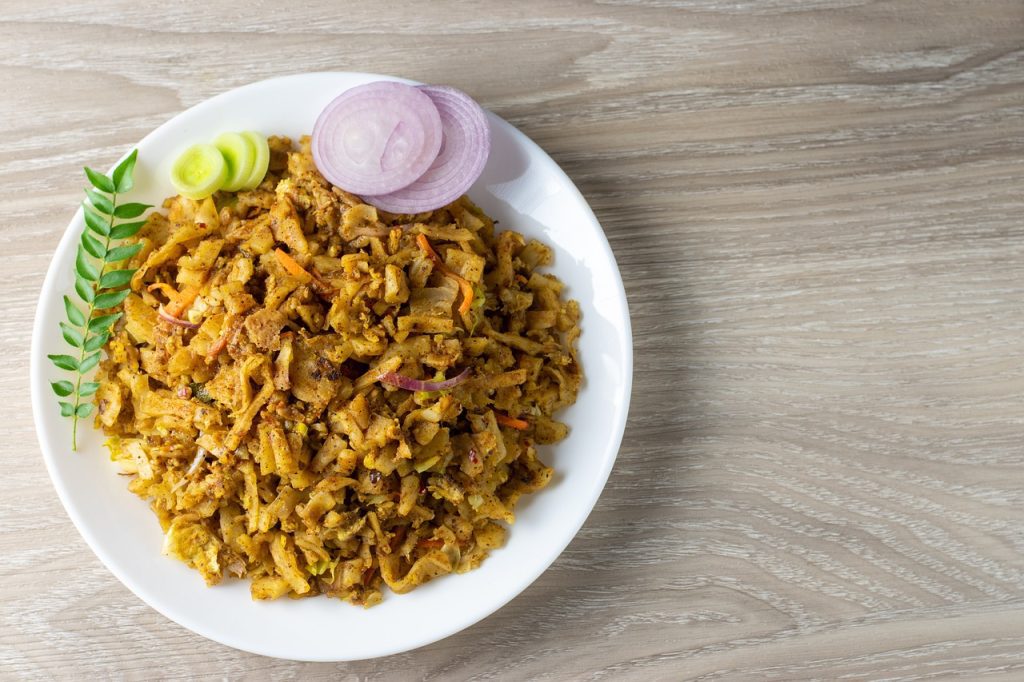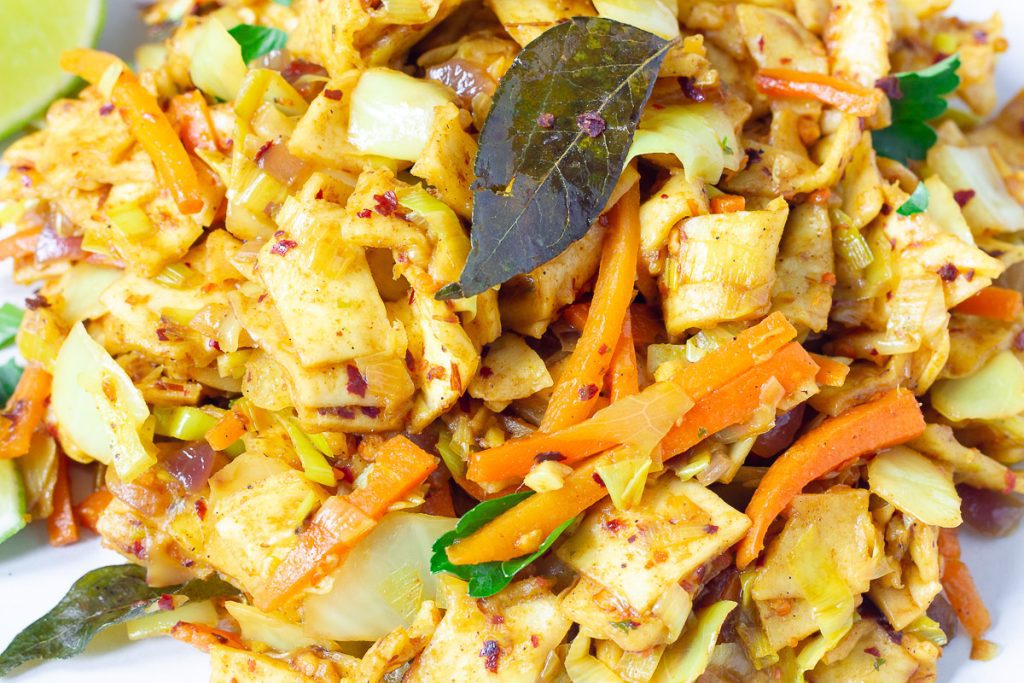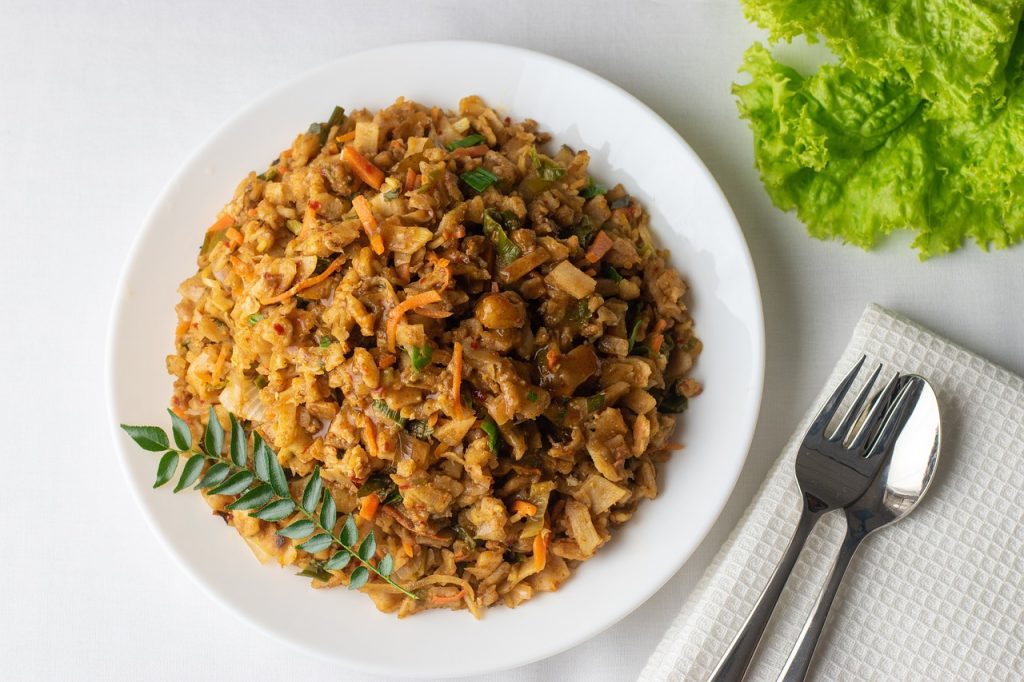Learn about Key Features of Vegetarian Kottu Roti. Discover the vibrant flavors of Vegetarian Kottu Roti. Learn how to make this delicious dish at home with fresh vegetables and aromatic spices. A perfect meal for vegetarians craving a hearty, savory bite.
Introduction
Kottu Roti is a very popular street food in Sri Lanka which includes stir-fried chopped roti (a type of flatbread) with many vegetables and spices including eggs or tofu sometimes for protein. As far as I have always known Kottu Roti is traditionally a meat dish. The focus shifted to the vegetarian kottu which instead offered meatless mixed vegetable kottu with delicious carrots, cabbages, onions, and bell peppers spiced to perfection.
Shredded roti is incorporated into the stir-fry to deliver a pillowy heavy meal. Other spices used in this dish include cumin, coriander, turmeric, and curry leaves, which provide an extrinsic character to the dish. Kottu Roti is also served along with sauce dips or curry for accompaniment. It’s a wholesome, rich, and colorful dish ideal for a filling, vegetarian meal.

What is Kottu Roti?
Kottu Roti is primarily a stir-fried dish prepared with yesterday’s flatter bread cut into tiny squares and mixed with many other things. Normally, the dish contains eggs or meat, although this vegetarian variation does not include these items and adds more vegetables and tofu or paneer for extra protein. It is done on a hot flat iron called a ‘griddle’ and combined with stirring metal spatulas or blades which makes a sound that throbs in the environment in the streets of Sri Lanka.
Ingredients
1. Godhamba Roti
What makes Kottu Roti a true delight is godhamba roti, a delicate flatbread that resembles paratha. The roti is cut into smaller pieces similar to those used in making a stir fry. In case one does not have a homemade godhamba roti, one can use the ready-made ones, which are also available in the market. Moderately thick and slightly elastic, it forms the core of the street dish by taking in all the tastes of the vegetables and spices used.
2. Vegetables
Verbose Kottu Roti is full of life and rich in vegetables. Most often cabbage, carrot, onion, and leek are used. For an even better taste and variety, bell pepper, green bean or spinach can be added. These vegetables serve the purpose of adding texture crunch and nutrition to offset the spices and make the meal healthy.
3. Spices and Aromatics
This particular dish makes use of Sri Lankan spices to create the flavor that it is known for. Curry powder, turmeric, cumin, chilies, and pepper rub are the main components. In addition, ginger, garlic, and green chili provide the right culinary heat. These spices when used enhance the heat as well as the “cultural ethnic” factor found in Kottu Roti.
4. Soy Sauce
A few drops of soy sauce are added to Vegetarian Kottu Roti to bring out the savory taste a bit more. This ingredient which is usually composed of umami enhances the flavor of the dish by marrying well with the other spices and vegetables. Soy sauce is not a traditional ingredient from Sri Lanka, but it does present a contemporary element to the dish and enhances the taste of the dish without any clash with other spices.
5. Eggs or Tofu
Some vegetarian Kottu Roti may also contain scrambled eggs or tofu to enhance the protein content. Among vegetarians, tofu can be used as a protein source while for others, scrambled eggs can be used instead as a filler. Both these sides help mash up the whole chopped roti along with the vegetables, making the meal a little more wholesome and healthy.
6. Condiments
The final dish should be garnished with fresh herbs such as cilantro and lime juice to enhance its flavor. These ingredients serve as a cooling component amidst the spices, mellowing the hot tones and bringing a tangy note to the end. This dish has a light satisfying quality that is due in part to the fresh flavor of cilantro and the tartness of lime.
Preparation
1. Roti Chopping
Chopping the godhamba roti into small pieces is important to the texture of the dish. After this is done, the roti is ready to absorb the spices and blend well with the vegetables. If frozen roti are used, it is better to heat them first before chopping to keep the texture when it is stir-fried.
2. Vegetable Sauté
Preparing the dish starts with the cooking practice of sautéing the vegetables in oil. The trio of base ingredients of onion, garlic, and ginger adds to the depths of flavor of the dish. Stir-frying the vegetables until soft enables absorption of spices into the mix when served, and also ensures that the roti is accompanied by a soft and tasty filling that is rich in flavor and fitting to fill the roti.
3. Spice Mix
When the vegetables have been cooked and softened, spices are thrown in to add heat and taste to the dish. The spices always contain curry powder, turmeric, Cameron, and flake chilies. If the spice level has to be controlled, the amount of the chili can be varied. The onions and tomatoes are properly spiced with the aromatic spices, making a very appetizing and thick base for the roti.
4. Mix in the Roti
The vegetable-spice mixture is then tumbled with chopped roti, which irr helps in bringing out the taste of the roti for the vegetable stir fry. The outside layer of all of the placed roti pieces gets fried just enough to become crispy but the rest of it remains soft. At this point in the process, tofu or scrambled eggs also get thrown in so that all the ingredients are coated with spices while also being cooked properly.
5. Finishing Touches
To complete the preparation of the meal, a bit of soy sauce is thrown in to boost the flavor of the dish. The ingredients are then tossed and cooked until hot and combined. This last step allows the flavors to deepen and prevents the roti and vegetables from being separated from each other, making it a harmonious and well-composed dish that is ready for serving.

6. Garnish
After being plated, Vegetarian Kottu Roti gets a sprinkle of fresh cilantro and a dash of lime for taste. Such components enhance the plate, adding a factor contrary to the spice and savory foundation of the dish. The garnishing enhances color, and shape and adds flavor, thus making the final dish not only delicious but also very beautiful.
Variations of Vegetarian Kottu Roti
Vegan Kottu Roti
Vega Kottu Roti is the constituent-free counterpart of the conventional Kottu Roti dish. One may add tofu or chickpeas in place of the paneer or egg. Of course, ghee or butter cannot be used on the roti as the roti itself should be vegan so a plant-based margarine should be used instead to oil the roti. For more enhancement, of the taste, one may add mushrooms and a bit of spinach with light coconut milk. In this case, the distinct flavor of Kottu Roti has been retained for those who are vegans.
Gluten-Free Kottu Roti
Possible fried gluten-free roti other than flatbread. Replace Godhamba roti, which is the traditional ingredient for a Kottu Roti, with either rice, chickpea, buckwheat, or quinoa-made flatbreads or tortillas. Likewise, ensure that all other mixes and condiments are also gluten-free. The dish combines the roti strips with vegetables and spices just as the original dish one enjoys its unique taste and texture. Kottu Roti low on gluten is suitable for a Sri Lankan cuisine lover suffering from gluten intolerance.
Key Features of Vegetarian Kottu Roti
1. Versatility
Kottu Roti, particularly the Vegetarian Kottu Roti is all the more interesting because of its Many applications. The dish Kottu Roti can be easily adjusted with several in-season vegetables, such as bell peppers, zucchini, or even mushrooms. To enhance the protein level, one can add tofu, scrambled eggs, or even faux meat. This flexibility certainly ensures that it caters to most diets while still maintaining its high nutritional value.
2. Spice Level
Kottu Roti is spicy and delicious as many people know it and its preparation involves the use of large quantities of curry powder, cumin, and chili flakes. However, some may sample variations of the spice levels according to how they feel about the spices. For example, are you the type of person that enjoys eating, but does not like the heat? If so, you can always cut back on the use of chili during the cooking process. Then again, if you are the type that loves the heat, it is possible to add extra green chilies or peppers into the dish to make it spicier.
3. Quick and Satisfying
The Vegetarian Kottu Roti is simple and quick to cook, which makes it an eye-ideal dish for case busy weekdays or last-minute dinners. Even with the fewer ready-to-eat ingredients, it’s a dish that fills one’s stomach easily, especially with all the flatbread, veggies, and protein that comes with them. This one-pan meal is very convenient since it can be prepared in thirty minutes or less, hence it is best for it for lunch or supper.
Nutritional Benefits
Kottu Roti, Vegetarian in nature, is healthy and is a complete meal. The fiber content in the vegetables is healthy for digestion and it can be supplemented by adding tofu or eggs for protein. Turmeric and cumin among other spices have antioxidants and anti-inflammatory qualities. This nutritious value makes Kottu Roti Vegetarian not only tasty but also very nutritious, healthful, and helpful in providing the body with clean ingredients.
Serving Suggestions
The Vegetarian Kottu Roti is usually accompanied by some ethnic condiments from Sri Lanka to enhance the taste of the dish. Often, ‘pol sambol’ is a favored addition, which is a fresh healthy spicy coconut condiment. Another preferred condiment is ‘lunu miris which is slightly tangy in taste and is made up of ground onion and chili paste, which goes well with the dish. Finish this with either faluda served chilled or masala tea served hot depending on which drink want to be a refreshing or warm comfort drink.
How to Make It Gluten-Free
If you’re gluten intolerant, a gluten-free Kottu Roti can be made by using gluten-free roti or flatbread instead. These can be purchased from health food stores or prepared at home using gluten-free flour variants. Other than that, all other ingredients are similar, hence it is quite easy to modify this dish to suit different dietary requirements.
Can You Find It at Restaurants?
Yes, Vegetarian Kottu Roti can be found in plenty in Sri Lankan hotels and food kiosks, especially in places with a high concentration of Sri Lankan populace. Some places offer variations of the dish, so feel free to ask for more spices or a ‘no meat’ option.

FAQs
Can I make this dish vegan?
Of course, just leave out the eggs and substitute coconut oil or another plant-based oil for stir-frying.
Is Kottu Roti healthy?
Yes, especially the vegetarian variant because it is mostly green and contains whole spices. If you wish, you can opt for whole wheat roti which is a more health-conscious alternative.
How can I adjust the spice level?
Chili powder can be added or omitted as per the person’s heat tolerance level. Yogurt and raita are also effective in countering heat.
Conclusion
Vegetarian Kottu Roti is a flavorful and dynamic dish comprising many textures and spices, making it comforting to eat. The chopped roti, rich vibrant vegetables, and spices just explode the flavors in your mouth. Due to this flexibility, it is not surprising that the dish offers itself to any vegetarian and spice lover; hence it is one of the street foods from Sri Lanka that generously allows for the richness and diversity of the cuisine of any person who relishes bold, hearty dishes.
